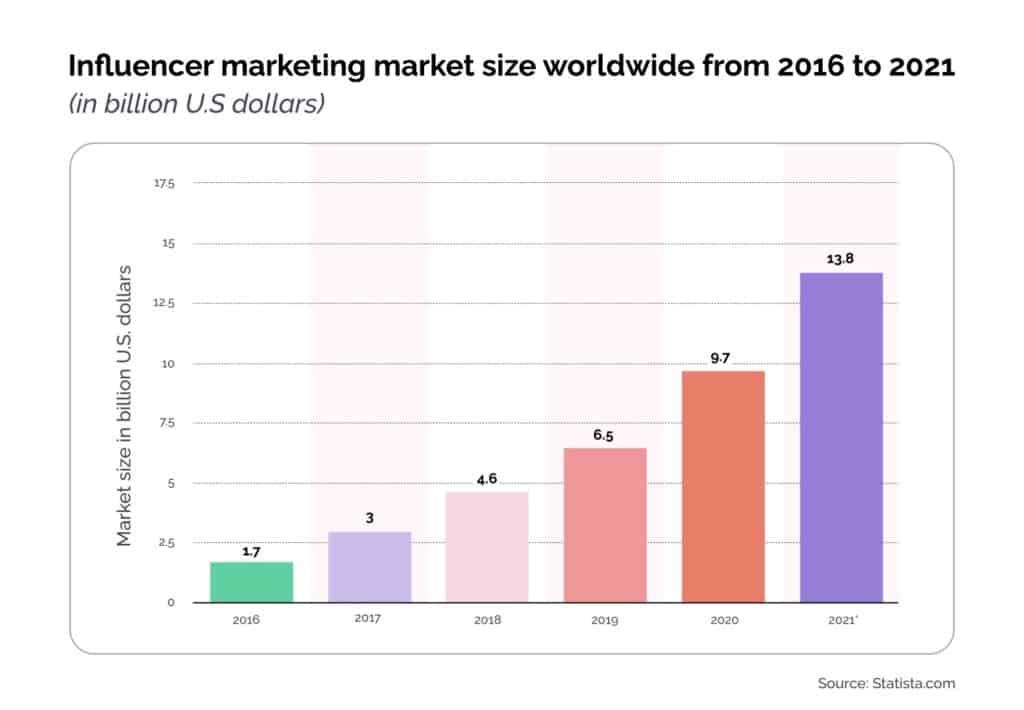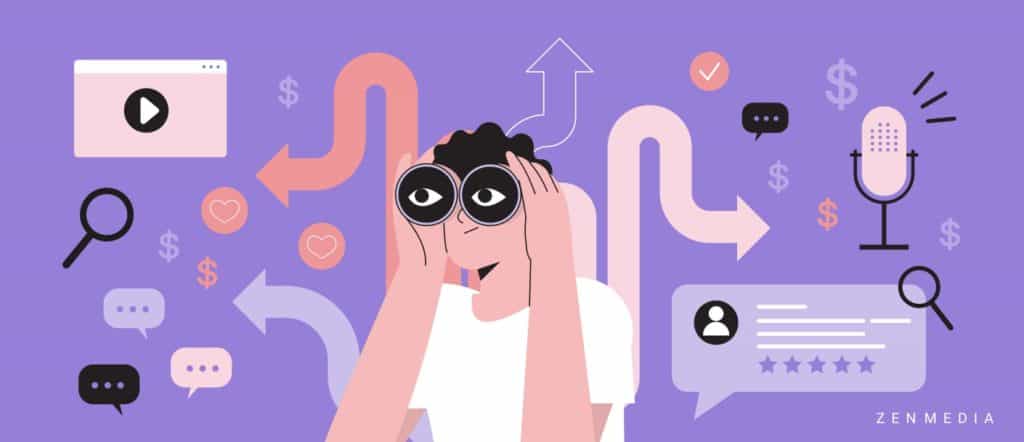We’re all buying something. The question is: do you trust brands to best represent themselves and what they offer?
The answer: probably not.
Think about it: As a buyer, who are you trusting when it comes to what services and products to buy?
Odds are, you’re trusting another buyer—a previous customer who already has the product or uses the service.
We can thank the creator economy for that. The global influencer marketing market size has more than doubled since 2019—yes, you read that right. According to Statista, the market was valued at a record $13.8 billion in 2021, and the increase is simple, really; buyers trust other buyers—or at least people claiming to be subject-matter experts (SMEs).

So, when you’re working on your company’s B2B marketing strategy, sales collateral should be a part of it. After all, you want your customers to establish trust, right?
But What Exactly is Sales Collateral?
Many make the mistake of assuming that sales collateral boils down to a Yelp review. And let’s be clear, reviews are a very powerful type of sales collateral, but there’s more to it than that.
While user-generated content (UGC), like reviews, are fantastic forms of sales collateral, you can develop strong sales collateral internally as well.
Sales collateral is essentially any content that helps your prospect feel comfortable—nay, excited, even!—at the thought of spending their hard-earned money with your brand.
Perhaps one of the most prevalent and well-known forms of sales collateral is the catalog. Whether it’s for Scholastic Books or Sears and Roebuck, the catalog was an incredibly powerful form of sales collateral in years past because it moved past just telling someone about a product. It provided the features of the product, an image of the product, and—yes, sometimes—a testimonial or review. As we’ve transitioned away from print media, catalogs still reign supreme in many contexts—after all, isn’t Amazon essentially one big catalog?
Let us elaborate.
Simple promises from sales and marketing departments simply aren’t enough to justify investments from consumers anymore. We want proof that your products and services are worth it. In some cases, that means knowing the specs—what material is your product made out of? What size is it? How often does it need to be cleaned/charged/reset?
And in others, it means that UGC—reviews, testimonials, and so on.
The goal is to use sales collateral to help support and unify your messaging at the point of sale. If the messaging is unclear, your buyer may second guess their choice and abandon their cart, so to speak. The best way to move your buyer from the decision-making stage to converting is by presenting sales collateral that reaffirms their trust in your brand, giving them peace of mind when they pull out their credit card.
How to Create Sales Collateral that Sells
You don’t just want sales collateral; you want sales collateral that actually sells, right? Follow these marketing tactics to make sure you’re creating sales collateral that sells.
Establish Social Proof
It’s the modern-day “word of mouth,” and an important part of our current sales funnel—social proof is literally your existing customers validating that your product or service works.
Loyal customers are also your most profitable customers. They’re the bread and butter for your business—and they’re also your best salespeople.
Related reading: Acquisition or Retention? The Results Are In: B2B Marketers Need to Focus On New
When your sales counselor Bob says a product is amazing and sure to solve a customer’s problem, it just doesn’t carry the same weight as when loyal customer Lisa says the same exact thing.
Why? Because there’s nothing in it for Lisa. She’s just sharing her experience.
So social proof is basically Yelp reviews, right?
Not exactly. Social proof can take many forms. Some of the most popular are definitely reviews, but others include:
- Case studies
- Testimonials
- White label success stories
- Logos
- Organic UGC
- Contracted UGC
- Media mentions
What you’re looking for in all of these materials is a consensus. You need as much glowing testimony as possible, to the point that the greatness of your brand is irrefutable.
So what are these types of social proof? Let’s break them down:
Social Proof
Include Client Reviews
Starting with the most obvious, reviews.
No matter your industry, reviews are crucial for all businesses.
Public reviews are pivotal in helping buyers determine if they can trust your brand and product. And smart marketers will pay attention to negative reviews too, so they can determine where shortcomings exist and whether they can be rectified.
Strong reviews can be repurposed—the quotes can be added to your website, as can any star ranking that may exist. And even negative reviews can be used for positive sales collateral—a tactful response and dedication to fixing the issue can compel 1-star reviewers to update their reviews, and even if that doesn’t occur, negative reviews give your brand an opportunity to show potential buyers how you handle criticism and how you fix problems.
Reviews are common across social media platforms, the Better Business Bureau, and more, depending on your industry. Part of your job when using reviews as sales collateral is determining which platform offers the biggest advantages for your brand and asking your existing customers to show you some love on that platform.
Are you aiming to be top of mind? Then Google Reviews will be the first thing your potential buyers see.
Are you aiming to have a social presence? Then you might want to steer your customers towards Facebook, etc.
Create Case Studies
What is a case study? It’s a narrative that shows how you helped a client solve a problem. They usually reference your client by name and use direct quotes. The best case studies are highly relatable, and your prospects can envision their own problem being solved in the story.
They also include lots of hard data, visuals of the work completed (if applicable), the client’s goals, and the length of time it took to meet them. Essentially they show why you’re great at what you do.
Reach out to your clients and engage with them. Many will be more than happy to partake in a case study, especially if you sweeten the deal with incentives like discounts or add-ons.
Testimonials
If you have a newer company—especially in the B2B space, where the long buyer journey can mean it takes some time to build a customer list—you simply might not have enough data to showcase why your company is worth believing in.
It’s too soon. There’s only so much compelling info you can provide without having actually helped several customers.
That’s where testimonials come in.
While reviews are the uncensored recordings of experiences and perspectives, testimonials are the curated or requested feedback from customers.
To put it frankly, testimonials are nearly always positive because they are directly solicited. This means that if you only have one or two customers, you call them up and ask them to tell you about their experience directly. You can record a video about their experience or pull a quote from their feedback—or you can ask them to send you a video or thought-out quote.
Alternatively, you can curate a testimonial, which is essentially finding a review that speaks positively about your brand and pulling the best snippets for a feature on your website or social media.
Related reading: 4 Practical Steps To Building Trust For B2Bs
Feature White-Label Success Stories
Sometimes, data is all you have, but maybe you can’t use your customer’s name. In these cases, a white-labeled success story will do. Though not as powerful as case studies or reviews, a white label story still helps illustrate how you serve your clients and the types of success they can have if they buy from your brand. And when you work in an industry where client bases are guarded, something is better than nothing.
List Logos
This may seem obvious, but logos matter—a lot. We’ve all seen those listicles of the best—and worst—logos out there. The best ones all have something in common: They make people feel at ease.
And how, exactly, do you make prospects feel comfortable with your logo? You have to become recognizable. Once prospects start to recognize you, you become more trusted and less suspicious.
And, especially for B2Bs, you can also gain value from showing that you work with other companies that are recognizable. Something as simple as prominently featuring these logos somewhere on your site can give the impression that these recognizable (and therefore, trustworthy) companies trusted you, so they should too—and that goes a long way toward building your credibility.
Watch for Organic UGC
The most common type of user-generated content is in the form of social media posts and shares. You want customers to talk about a product or service that they are using and enjoy using. If someone is using the product on video, that’s even better. So how do you get people to post about your brand on social media?
One way is to make sure your brand is posting interesting and engaging social posts. Doing so will help you build a follower base that is engaged and willing to have conversations. This increases the odds that your users will share the content you posted or include you in their posts in other ways, like tagging your company or even writing their own posts about your brand or products.
Once you have UGC, you can repurpose it into strong sales collateral by sharing the UGC on your social channels in a variety of ways.
Related reading: How to Take Your User-Generated Content from Good to Great
Don’t miss out on great sales collateral developed on social. Make sure you are employing the right tools to track and locate mentions. Whether you prefer Hootsuite or Semrush, make sure you are searching for your company name, product names, any key hashtags that you use, as well as other branded language.
Consider Contracting UGC
It can be hard to get organic social media mentions, especially in the B2B space. In these cases, you might consider sending a subject-matter expert—like an industry-specific influencer—into the mix. B2B influencer marketing can help get the conversation going on social media, and using an SME will build your credibility as a company.
Related reading: 10 Criteria You Should Look At When Identifying Influencers For B2B
The content your contracted influencer develops can be repurposed on the company’s social accounts and, depending on the type and quality, on your company website.
Media Mentions
Media mentions do a lot to create awareness and credibility for your brand, and they can be used for sales collateral as well. The key is to use your PR.
B2B PR shouldn’t stop the moment your press hit is secured. That is just the beginning. To turn your press mentions into powerful sales collateral, you need to amplify, share, and connect the dots. When you get PR hits, put them on your website, share them on your social media channels, and use them to start conversations. You want to make sure that potential buyers know that people—and publications of note—are talking about your brand.
Want to expand the reach even further? You can talk about those media hits on a podcast, or even revisit them when a current event ties in to what was covered or talked about. Keeping your media mentions fresh is essential when it comes to using them later in your sales materials.
Related reading: Why Every PR Campaign Needs Social Media
So, long story short—use everything. Don’t miss out on an opportunity to build credibility and trust. Each interaction, mention, experience, and perspective has the potential to help prospects better understand and trust your brand.
Need some help turning your marketing and PR strategy into a sales collateral machine? Reach out. Let’s make some sales.




